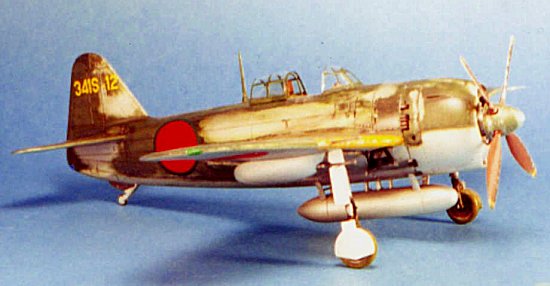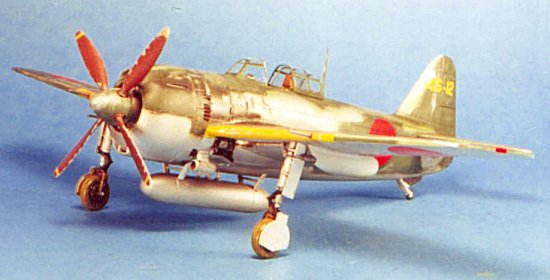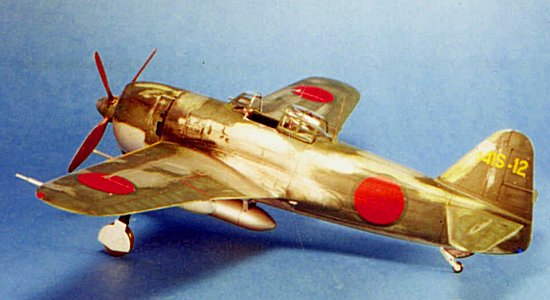
Tamiya 1/48 N1K1-J Shiden
|
KIT # |
61038 |
|
PRICE: |
$23.00 |
|
DECALS: |
See review |
|
REVIEW : |
|
|
NOTES: |

|
HISTORY |
The Second World War fighter with perhaps the most improbable development history was the Kawanishi Shiden (Violet Lightning) known to its enemies under the code name "George," which began life as a floatplane fighter and went on to become the Japanese Navy's most potent land-based interceptor. It was among the finest combat aircraft created by the Japanese during the war, superior in most respects to the carrier-based U.S. Navy fighters which opposed it; only the lack of pilots qualified to make the most of its potential, and the limited production that resulted from the B-29 bombing campaign prevented the Shiden from being as well known as the Zero.
Originally created as the N1K1 "Kyofu," the aircraft was the most powerful sea-based fighter airplane ever created. (Editor's note: At least it was until the development of the British Saunders-Roe SR.A/1Seaplane jet fighter of 1947, and let's not forget the Convair YF2Y-1'Sea Dart', though both types were cancelled before they saw unit service.) Development difficulties with the Mitsubishi Kasei (Mars) engine, kept the airplane from entering service at a time when its qualities would have been of use, during the Guadalcanal campaign. By the time it emerged in production form in 1943, the need for such an aircraft had changed drastically, and only 97 were produced between June 1943 and March 1944 when the program was cancelled.
 By 1942, the Japanese
Navy needed a high-altitude fighter of advanced performance to combat the later
Allied fighters and bombers that were appearing. With the J2M Raiden and J3K1
project facing technical delays, the Navy needed a land-based interceptor fast,
and suggested to Kawanishi that a landplane fighter might be developed from the
"Kyofu."
By 1942, the Japanese
Navy needed a high-altitude fighter of advanced performance to combat the later
Allied fighters and bombers that were appearing. With the J2M Raiden and J3K1
project facing technical delays, the Navy needed a land-based interceptor fast,
and suggested to Kawanishi that a landplane fighter might be developed from the
"Kyofu."
The N1K1-J "Shiden" got rid of the Kasei, substituting the equally-troublesome Nakajima NK9H Homare 21 radial. Despite the teething troubles created by the engine, the modified design Kawanishi came up with looked so good that the Mitsubishi J3K1 project was suspended in its favor. The first prototype Shiden flew in July 1943; it utilized the wing and tail of the "Kyofu" with little modification, though the new engine necessitated extensive redesign of the fuselage. Also, with a mid-wing design and a large propeller, the landing gear had to use double-retraction, to solve the problem of exceptional length. An outstanding feature of the Shiden was its exceptional maneuverability, through use of a unique "combat flap" system in which the flaps automatically changed their angle in response to changes in "G" forces, thus supplying additional surface when a high lift coefficient was needed. The automatic operation eliminated the possibility of stalling at a moment when such an act would prove fatal. The Shiden carried an armament of two 7.7mm machine guns in the cowling, and four 20mm cannon - two in the wings and two in individual gondolas under each wing.
Full production was attained by the summer of 1944, though there was no time to cure the engine problems that manifested in prototype testing. As a result, the production lines were continually inflicted with design changes and modifications that slowed production of finished aircraft to a crawl. Total N1K1-J Shiden production was 1,007 aircraft, including the 8 prototypes. The production N1K1-J Model 11 Shiden had a top speed of 367 mph, with service ceiling of 39,700 feet. Unfortunately, the performance fell off drastically above 25,000 feet, which would make the airplane virtually useless in opposing the B-29s when raids commenced from the Marianas in November 1944.
 The Shiden entered
service in early 1944, and gained a reputation among Allied fighter pilots as
one of the most troublesome Japanese fighters to be met in combat. In the hands
of a capable pilot, it was more than a match for the F6F Hellcat, which was
regarded as an easy kill for a pilot of any experience. Shidens equipped the
343rd Air Corps on Tinian and first fought in the Marianas, where they were
vastly outnumbered by their U.S. Navy opponents. The first large force of
Shidens to meet U.S. forces were the aircraft of the 341st Air Corps, which
arrived on Luzon from Formosa on October 20, 1944, four days before the U.S.
invasion of the Philippines. Although the 100 Shidens of the 341st fought well,
they were soon impotent due to the lack of spares for the aircraft not lost in
action.
The Shiden entered
service in early 1944, and gained a reputation among Allied fighter pilots as
one of the most troublesome Japanese fighters to be met in combat. In the hands
of a capable pilot, it was more than a match for the F6F Hellcat, which was
regarded as an easy kill for a pilot of any experience. Shidens equipped the
343rd Air Corps on Tinian and first fought in the Marianas, where they were
vastly outnumbered by their U.S. Navy opponents. The first large force of
Shidens to meet U.S. forces were the aircraft of the 341st Air Corps, which
arrived on Luzon from Formosa on October 20, 1944, four days before the U.S.
invasion of the Philippines. Although the 100 Shidens of the 341st fought well,
they were soon impotent due to the lack of spares for the aircraft not lost in
action.
The Shiden was next met in combat over Okinawa. In a demonstration of the airplane's ability, a unit of 34 Shidens came across 70 U.S. Navy fighters over Anami Oshima island, destroying 20 for a loss of 12. The airplane continued to be met in combat over the island chain until the end of the war, as well as participating in the defense of the homeland that summer.
|
THE KIT |
Tamiya first released their kit of the N1K1-J Shiden in 1996. It is an excellent example of the company's trademark high-quality production design and engineering. The kit goes together quickly and easily, allowing even a beginner to create a good-looking model from this kit.
I obtained this kit at a "distressed kit auction" at my local model club, which resulted in me becoming the owner of a box of parts that included enough wings for three models, one complete fuselage, and two sprues of other parts. There were no decals or clear parts, but the price of $2.50 was a bargain. I quickly obtained the Squadron vacuform canopy for the Shiden, as well as the Aeromaster sheet 48-326, which provides decals for four different Shidens. I chose to do 341-12S of the 341st Air Corps, as photographed on Luzon. My reason for choosing this particular one is that the photograph showed clearly the "distressed" nature of the camouflage paint, which had come off large areas of the airframe - thus I could make a "distressed" Shiden from the "distressed" kit.
|
CONSTRUCTION |
Construction of this kit is easy, following the kit instructions. I airbrushed the interior in "Nakajima Green", as shown in the color photos of the very accurately restored Shiden-Kai in "Aero Detail No. 26 - Shiden Kai." I highly recommend this book for any modeler who wants to make a model of this airplane, particularly anyone who plans to build the excellent new Hasegawa kit of the ultimate Shiden, the Shiden-Kai Model 21. I also painted the engine in a variety of metallic colors per the photos in this book.
Once the paint was dry, assembly was rapid, with the basic model completed in only a few hours of work.
|
PAINT & DECALS |
 I first painted the
entire model with SnJ Aluminum paint, then covered that with Testor's Metalizer
Sealer, since I was going to use a variety of acrylic thinners on the
camouflaged surfaces and didn't want to harm the undercoat.
I first painted the
entire model with SnJ Aluminum paint, then covered that with Testor's Metalizer
Sealer, since I was going to use a variety of acrylic thinners on the
camouflaged surfaces and didn't want to harm the undercoat.
I then painted the model. First I painted the lower surfaces of the ailerons and elevators with IJN Grey, then the upper camouflage, using a mixture of Gunze-Sanyo IJN Green and Medium Green to get "Kawanishi Green," a slightly blue-toned green similar to but more green than "Nakajima Green." (I matched this to the color photos of the restored Shiden-Kai in the Aero Detail book.) [Editor's note: if you can still find it, Aeromaster produced a Kawanishi Navy Green in their paint line.] Once this was on and dry, I used Scotch shiny transparent tape to lift off various bits of paint, pulling it off as I lifted the tape. I then applied rubbing alcohol to sections of the painted surface, allowed it to sink in, then rubbed off the acrylic paint with a cotton cloth over one finger. The end result, as you can see in the photos, gives the effect of paint having peeled off large areas of the airframe. Doing it this way is more realistic in the final result than dry-brushing aluminum paint over the camouflage paint; while that works well for limited little dings and scrapes, it looks completely unrealistic when done over large areas.
When this was done, I futured the model again, then applied the markings. When these were fully set, I used the Scotch tape, pressed over sections of the decals, to lift them off the aluminum areas, since the markings would largely have gone with the flaked-off paint. I then airbrushed "Flat Future" over the entire model, since it would have gone nearly dead flat in the existing conditions in the Philippines where the airplane was used.
I dry-brushed the prop tips with Testor's Aluminum (non-buffing) Metalizer paint, to simulate the wear that would happen with operations from an unimproved runway. Following that, I applied "mud spray" to the underside of the wings behind the landing gear, and applied exhaust staining with Tamiya "Smoke" thinned to give a semi-gloss finish that would have it stand out from the rest of the surface finish.
|
FINAL CONSTRUCTION |
 Once all the weathering was done, I attached the landing gear, prop, drop
tank and vacuform canopy which I cut so it could be displayed open.
Once all the weathering was done, I attached the landing gear, prop, drop
tank and vacuform canopy which I cut so it could be displayed open.
The result is a realistic-looking "George" and a very welcome addition to my collection of Japanese Navy fighters. It will look very good next to the coming Hasegawa Shiden-Kai.
Copyright ModelingMadness.com. All rights reserved. No reproduction in part or in whole without express permission from the editor.
If you would like your product reviewed fairly and fairly quickly, pleasecontact the editor or see other details in the Note to Contributors.
Back to Reviews Page 2024